The Dyslexic Syndrome
As previously noted, dyslexia is not just a severe reading disorder characterized by reversals. It is a syndrome of many and varied reading and non-reading diagnostically-specific symptoms.
The following is a highly summarized list of symptoms and their qualities typically found in dyslexics with inner-ear dysfunction. The specific qualities of these symptoms were proven by Dr. Levinson to be reliable indicators of inner-ear/cerebellar dysfunction.
Take our Self-TestThe Dyslexic Syndrome
Reading
|
Writing
|
Spelling
|
Memory
|
Speech
|
Math
|
Direction
|
Time
|
Grammar
|
Concentration and Activity
|
Balance and Coordination
|
Psychosomatics
|
Self-esteem and Body-image
|
Phobias and Related Obsessive/Compulsive Disorders
|
Mood Disturbances
|
Typical/Diagnostic Dyslexic Symptoms
Reading Errors
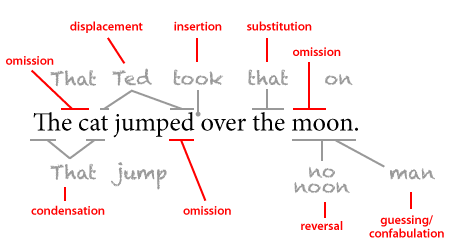
Click to enlarge
The "typical" dyslexic errors and mechanisms triggered when a reading-disabled sample attempts to read the sentence, The cat jumped over the moon. By means of an error analysis and diagram, the mechanisms underlying the dylexic reading performance are reconstructed.
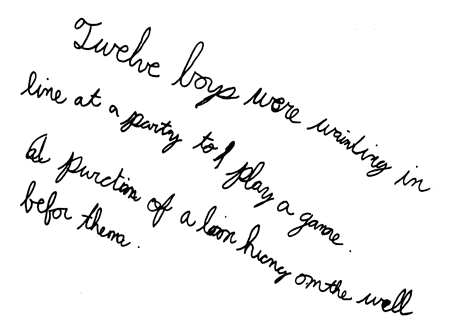
Click to enlarge
An 11-year-old dyslexic was instructed to read and then copy several printed sentences into script. The writing drifts significantly from the horizontal. Letters are poorly formed and spaced, as well as inappropriately omitted, inserted, and condensed. Occasionally, letters from successive words are fused or condensed. Grammatical details such as crossing t's are intermittently and carelessly omitted.
Writing Errors
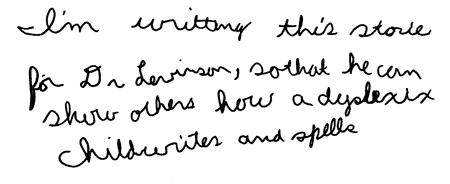
Click to enlarge
Graphomotor spelling errors of a bright 10-year-old dyslexic girl. A neurodynamic analysis of the spelling errors suggests a dysfunction in the visual-motor memory of letter sequences and the use of compensatory phonetic recall. Letters and letter pairs are perseverated, and at times inappropriately fused or condensed. Moreover, the spelling disorder is complicated by graphomotor incoordination, drifting, and the omission of grammatical details. Interestingly enough, this girl's oral spelling was found to be superior to her graphomotor spelling, suggesting that the motor channel utilized to test spelling may significantly alter the performance.
Spelling Errors
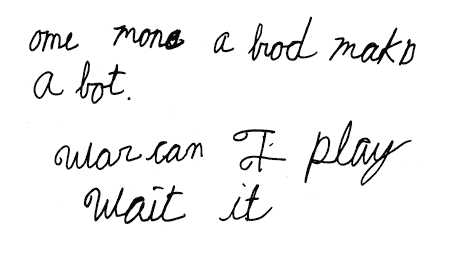
Click to enlarge
Spelling performance of an 8?-year-old dyslexic girl asked to write a few sentences she just read. Her visual-motor memory for sequential letters is severely deficient. Letters and syllables are omitted or substituted for one another, and guessing or confabulation is determined by randomization plus phonetic cues.
Math Errors
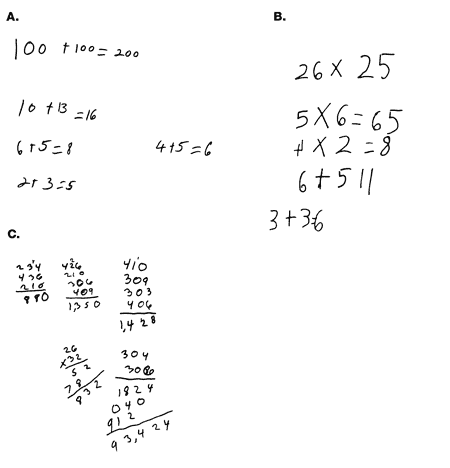
Click to enlarge
The mathematical errors in dyslexia may be of several distinct overlapping types: (A) "Simple" addition calculations such as 100 + 100 and 2 + 3 are remembered, whereas more difficult calculations are forgotten and the answers guessed at or confabulated; (B) A similar memory instability for multiplication. When asked to write and multiply 2 x 6 and 2 x 5, the 9-year-old mentally condensed the numbers, writing 26 x 25. When asked to write and calculate 5 x 6, he guessed at an answer, and the guess was merely a condensation of the two numbers written. He did understand and remember 4 X 2 = 8, but reversed the 4. As noted, he recalled addition, but forgot to put in the equal sign when adding 6 + 5, and belatedly added it to the equation 3 + 3 = 6. (C) The multiplication ability of a 10-year-old dyslexic. The numbers are occasionally poorly formed and the column alignment drifts to the right. Needless to say, graphomotor and spatial incoordination may result in careless errors, despite superior conceptual and memory ability.
